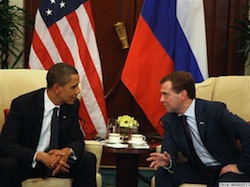Looking beyond the START Follow-on
December 18, 2009
Featured Image
We are happy to serve you a daily summary of the day's top nuclear policy stories each morning, with excerpts from the stories in bullet form.
Stories we're following today:
Nearing New Arms Pact, U.S. and Russia Look Beyond It - New York Times [link]
- But even if the two sides manage to bring home a deal in coming days as they hope, that will be the easy part. After President Obama and President Dmitri A. Medvedev of Russia sign the new pact, they plan to send negotiators back to the table next year to pursue a far more ambitious agreement tackling whole categories of nuclear weapons never before subject to international limits.
- The talks envisioned for 2010 would continue to advance Mr. Obama’s disarmament agenda and attempt what no president has managed since the dark days of the cold war. In addition to further reducing deployed strategic warheads, the negotiations would try to empty at least some vaults now storing warheads in reserve. And the two sides would take aim at thousands of tactical nuclear bombs most vulnerable to theft or proliferation, some still located in Europe 20 years after the fall of the Berlin Wall.
Obama, Medvedev to Meet on Nuclear Weapons Talks - Associated Press
- As the two sides seek a breakthrough, President Barack Obama and his Russian counterpart, Dmitry Medvedev, plan to discuss the nuclear negotiations in a meeting Friday on the sidelines of United Nations climate talks in Copenhagen, Denmark. The two leaders are not expected to seal a deal.
- U.S. officials, speaking on condition of anonymity because of the sensitivity of the talks, say negotiations with Russia to replace the Strategic Arms Reduction Treaty have become hung up on a disagreement about how to monitor the development of new intercontinental ballistic missiles.
The Inertia Option - Roger Cohen in the New York Times [link]
- The main difference between Moscow 1989 and Tehran 2009 is that the Islamic Republic is still ready to open fire. The main similarities are obvious: tired ideologies; regimes and societies marching in opposite directions; and spreading dissent both within the power apparatus and among the opposition.
- I don’t know how long this situation can endure. Anyone who claims to be able to tell the Iranian future is lying. But it seems clear that the “political clock” has now outpaced the “nuclear clock.”
- All this says — nay, screams — to me: Do nothing. It is President Barack Obama’s outreach that has unsettled a regime that found American axis-of-evil rhetoric easy to exploit. After struggling, Obama has also found his sweet spot in combining that détente with quiet support for universal rights.
Prepared Testimony of Dr. Trita Parsi, President of the National Iranian American Council, for Hearing on "Iran Sanctions: Options, Opportunities and Consequences" - House Committee on Oversight and Government Reform [link]
- Given the current movement towards sanctions, I would like to address some of the factors that need to be taken into consideration when assessing various sanctions options.
- First, the impact of sanctions on the people of Iran has rarely factored into our calculations. The Iranian people have suffered the brunt of the economic pressures precisely because existing sanctions have been broad and untargeted. The Iranian government, meanwhile, has remained relatively unscathed and has shifted the pain of the sanctions towards the people.
- Second, the events of this past summer also shattered one of the myths about the ability of sanctions to bring about internal change in Iran. One effect of proposed gasoline sanctions, it has been argued, would be that ordinary Iranians, infuriated by skyrocketing gasoline prices, would increase their pressure on the Iranian government. However, past behavior of the Iranian populace does not support this theory.
- Third, the ability of sanctions to generate change is partly a function of international participation in the sanctions regime.
- Going forward, Washington must carefully calculate its policies vis‐à‐vis Iran and the utility sanctions can play within a larger Iran policy. Factors such as the impact of sanctions on the Iranian people and their struggle for democracy, the unintended effect sanctions can have on strengthening Iran’s ruling hardliners, and the ability of sanctions to divide rather than unite the international community must all be taken into account.
- Note: NIAC is a Ploughshares Fund grantee.
Nuclear Deal Seen as Model to Limit Atomic Arms - Associated Press
- The U.S. and a key Persian Gulf ally put into force Thursday a landmark agreement on nuclear cooperation that Washington sees as a model for limiting the spread of nuclear weapons.
- It creates a legal framework for the U.S. to transfer nuclear equipment, reactors and materiel for civil nuclear research to the emirates, a federation of seven semiautonomous sheikdoms that includes glitzy and now debt-saddled Dubai.
- For its part, the emirates commit to not enrich uranium or reprocess spent nuclear fuel for plutonium, which is used in nuclear bombs. It will buy fuel for its civilian nuclear reactors from abroad. The Obama administration reviewed the deal after taking office in January and submitted it to Congress in May.



